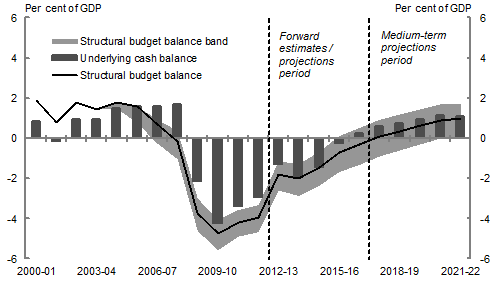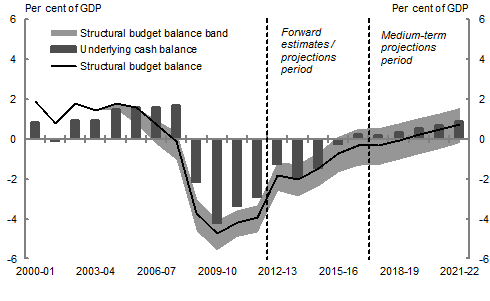This appendix presents updated estimates of the structural budget balance based on the methodology in Treasury Working Paper 2013‑011.
Estimates of the structural budget balance adjust for temporary factors that have a significant impact on the budget balance. For the Australian Government, these factors include cycles in the real economy, and deviations in the terms of trade and capital gains tax (CGT) receipts from their estimated long‑run, or 'structural', levels. Considered alongside underlying cash balance estimates and balance sheet indicators, structural budget balance estimates can provide broad guidance on whether current fiscal policy settings are sustainable over the medium term.
While structural budget balance measures are conceptually appealing, they are sensitive to the assumptions and parameters underpinning the estimates. Following a decade in which Australia's terms of trade doubled, to reach the highest level in at least 150 years, identifying the structural or long‑run level is conceptually challenging—using different assumptions for the terms of trade leads to substantial differences in structural balance estimates. In addition, the relationship between tax receipts and economic activity is complex and varies through time as the structure of the economy changes. Finally, international experience has demonstrated the difficulties in disentangling temporary from permanent economic factors, especially in real time.
For these reasons, it is best to consider a range of structural budget balance estimates based on plausible assumptions for the underlying parameters as one element of a broader assessment of fiscal sustainability. Chart G1 presents a range of estimates of the structural budget balance for the Australian Government.
Chart G1: Structural budget balance estimates
Note: The grey range represents the range of structural budget estimates using the OECD's assumption for the structural level of the terms of trade (average between 1986‑87 and 2010‑11), and using the average from 2003‑04 to 2015‑16 consistent with the 2013‑14 Budget. The OECD assumption generates the lower bound of the shaded region, while the 2003‑04 to 2015‑16 average assumption generates the upper bound.
Source: ABS cat. no. 5206.0, 5302.0, 6202.0 and 6401.0 and Treasury.
The range of estimates shown in Chart G1 suggests that the structural budget balance deteriorated from a surplus of around 1‑2 per cent of GDP in the mid‑2000s to a broadly balanced position by around 2007‑08. The structural balance deteriorated around 4‑5 percentage points with the onset of the Global Financial Crisis, but has since improved, with a structural deficit of around 1‑3 per cent of GDP estimated in 2012‑13. The range of estimates shown in Chart G1 suggests that the structural position of the budget will improve gradually over the forward estimates and return to a broadly balanced position over the medium term.
The estimated improvement in the structural budget balance over the forward estimates period shown in Chart G1 reflects announced policies as at the August Economic Statement. Beyond the forward estimates, the improvement in the structural budget balance is assumption‑driven and reflects the 'no policy change' scenario outlined in Appendix F.
Since the 2013‑14 Budget, the range of estimates for the structural budget balance has deteriorated slightly from 2012‑13 to 2013‑14, but has improved around ¼ of a percentage point in 2015‑16 and 2016‑17. The modest improvement in the estimated structural balance at the end of the forward estimates period reflects the Government's decision to offset the sharper decline in the terms of trade forecast at the Economic Statement through measures to keep the underlying cash balance on track to return to surplus in 2016‑17.
Chart G2 shows the implications for the range of structural budget balance estimates of relaxing the medium‑term assumptions, which are broadly consistent with the implications for the underlying cash balance projections shown in the 'underlying trend' scenario in Appendix F. The projected pace of improvement in the structural budget balance over the medium term projection period is slower initially relative to Chart G1 due to the relaxation of the constraint on real spending growth. The projected pace of improvement of the structural budget balance then accelerates due to the impact of relaxing the constraint on tax receipts as a share of GDP, leaving the estimated structural balance broadly the same at the end of the period as in Chart G1.
Chart G2: Structural budget balance estimates — without constraint on growth in spending and tax receipts
Note: The grey range represents the range of structural budget estimates using the OECD's assumption for the structural level of the terms of trade (average between 1986‑87 and 2010‑11), and using the average from 2003‑04 to 2015‑16 consistent with the 2013‑14 Budget. The OECD assumption generates the lower bound of the shaded region, while the 2003‑04 to 2015‑16 average assumption generates the upper bound.
Source: ABS cat. no. 5206.0, 5302.0, 6202.0 and 6401.0 and Treasury.
1 Win, N, Duggan, S, Garton, P, Premetis, S and Li, B, 'Estimating the Structural Budget Balance of The Australian Government: An Update', Treasury Working Paper, May 2013.

